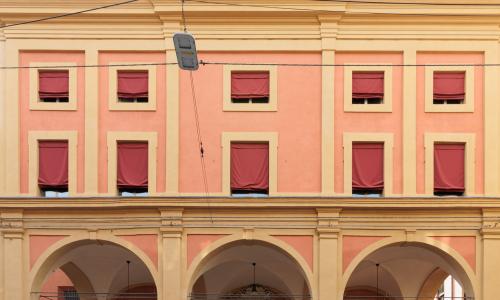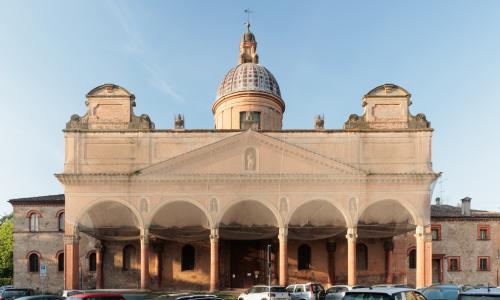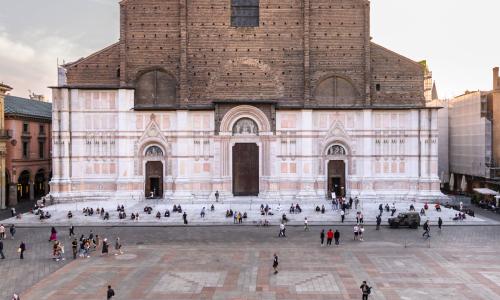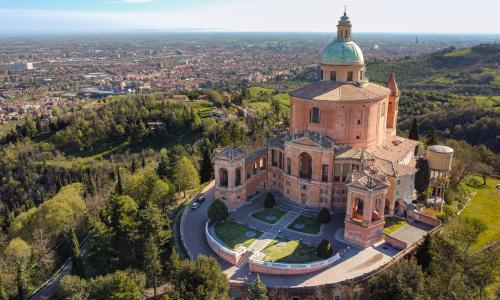Maps
Churches

Basilica of Santo Stefano
This is the most important example of sacred Romanesque architecture in Bologna.
It is composed of a complex of open and closed sacred areas, traditionally referred to as the "Seven Churches". The entrance is through the Church of the Crucifix (once a hall and raised presbytery, it consisted of two different churches), under which lies the Confession Crypt. A passage to the left of the main hall leads to the octagonal Holy Sepulchre and the solemn Church of Santi Vitale e Agricola. In the rear east section, beyond the Holy Sepulchre, there is the Pilato courtyard providing access to the Church of the Trinity; next to it is the cloister with two orders that lead to the convent located at the south end bordering Via Santo Stefano.
It is composed of a complex of open and closed sacred areas, traditionally referred to as the "Seven Churches". The entrance is through the Church of the Crucifix (once a hall and raised presbytery, it consisted of two different churches), under which lies the Confession Crypt. A passage to the left of the main hall leads to the octagonal Holy Sepulchre and the solemn Church of Santi Vitale e Agricola. In the rear east section, beyond the Holy Sepulchre, there is the Pilato courtyard providing access to the Church of the Trinity; next to it is the cloister with two orders that lead to the convent located at the south end bordering Via Santo Stefano.
Read more

Basilica of Santo Stefano
This is the most important example of sacred Romanesque architecture in Bologna.
It is composed of a complex of open and closed sacred areas, traditionally referred to as the "Seven Churches". The entrance is through the Church of the Crucifix (once a hall and raised presbytery, it consisted of two different churches), under which lies the Confession Crypt. A passage to the left of the main hall leads to the octagonal Holy Sepulchre and the solemn Church of Santi Vitale e Agricola. In the rear east section, beyond the Holy Sepulchre, there is the Pilato courtyard providing access to the Church of the Trinity; next to it is the cloister with two orders that lead to the convent located at the south end bordering Via Santo Stefano.
It is composed of a complex of open and closed sacred areas, traditionally referred to as the "Seven Churches". The entrance is through the Church of the Crucifix (once a hall and raised presbytery, it consisted of two different churches), under which lies the Confession Crypt. A passage to the left of the main hall leads to the octagonal Holy Sepulchre and the solemn Church of Santi Vitale e Agricola. In the rear east section, beyond the Holy Sepulchre, there is the Pilato courtyard providing access to the Church of the Trinity; next to it is the cloister with two orders that lead to the convent located at the south end bordering Via Santo Stefano.
Read more

Basilica of Santa Maria Maggiore
This important Basilica of ancient origin is nestled within its narthex in the porticoed curtain wall on the Galliera road. The 6th century beginnings and Romanesque transformations left the building oriented, as in Christian tradition, towards the east. This orientation was reversed in the Bentivoglio family era, according to some recent documentary findings, or later as illustrated in the historiography reports, with the transformations by Paolo Canali in 1665. In all cases, the façade is set on a portico surmounted by a unit that was used as a rectory. It was augmented with an additional level in the 17th century and crowned by a triangular pediment in 1956 by the engineer Giuseppe Coccolini.
Read more

Basilica of Santa Maria Maggiore
This important Basilica of ancient origin is nestled within its narthex in the porticoed curtain wall on the Galliera road. The 6th century beginnings and Romanesque transformations left the building oriented, as in Christian tradition, towards the east. This orientation was reversed in the Bentivoglio family era, according to some recent documentary findings, or later as illustrated in the historiography reports, with the transformations by Paolo Canali in 1665. In all cases, the façade is set on a portico surmounted by a unit that was used as a rectory. It was augmented with an additional level in the 17th century and crowned by a triangular pediment in 1956 by the engineer Giuseppe Coccolini.
Read more

Sanctuary of Baraccano
The Sanctuary of Santa Maria del Baraccano was commissioned by Giovanni I Bentivoglio. It is one of the many chapels built next to the city walls, in this case to shelter and protect an image of the Madonna and Child that was considered to have miraculous powers.
In 1524 a portico was added to the original construction.
In 1682 Agostino Barelli was commissioned to build the dome.
Due to the unique shape of the layout, there is no apse on the inside, and it is adorned with precious frescoes by Francesco del Cossa and by Prospero and Lavinia Fontana.
In 1524 a portico was added to the original construction.
In 1682 Agostino Barelli was commissioned to build the dome.
Due to the unique shape of the layout, there is no apse on the inside, and it is adorned with precious frescoes by Francesco del Cossa and by Prospero and Lavinia Fontana.
Read more

Sanctuary of Baraccano
The Sanctuary of Santa Maria del Baraccano was commissioned by Giovanni I Bentivoglio. It is one of the many chapels built next to the city walls, in this case to shelter and protect an image of the Madonna and Child that was considered to have miraculous powers.
In 1524 a portico was added to the original construction.
In 1682 Agostino Barelli was commissioned to build the dome.
Due to the unique shape of the layout, there is no apse on the inside, and it is adorned with precious frescoes by Francesco del Cossa and by Prospero and Lavinia Fontana.
In 1524 a portico was added to the original construction.
In 1682 Agostino Barelli was commissioned to build the dome.
Due to the unique shape of the layout, there is no apse on the inside, and it is adorned with precious frescoes by Francesco del Cossa and by Prospero and Lavinia Fontana.
Read more

Basilica of San Petronio
The 7th of June 1390 saw the laying of the first stone of this great church that the Municipality of Bologna decided to dedicate to Bishop Petronio. He lived there in the fifth century and was a crucial figure not only in terms of spirituality but also as a foundation figure of the identity of the people of Bologna. The design task was assigned to the architect Antonio Di Vincenzo, already working at the Palazzo della Mercanzia, the Church of Santa Maria dei Servi and elsewhere in the city, along with Andrea da Faenza. The building stands on a large area previously occupied by houses, towers and churches, the memory of which now lives on in the names of some of the chapels in the Basilica.
Read more

Beata Vergine di San Luca Basilica and Sanctuary
At the end of the long porticoed route we finally reach the Sanctuary. Contrary to the similar Basilica of Superga, to which the Bologna building was been paired in terms of landscape value, it has no traditional façade. Instead, the portico, in front of the entrance, lengthens its arms into the large square opposite with a sinuous curve ending at the two peaks punctuated by two niches similar to the Bonaccorsi Arch from whence it all began.
The creator of the design was Carlo Francesco Dotti, who erected the Basilica starting from 1723 on a previous 15th century framework, with building work continuing for a long time until 1743. The external niches are the work of his son Gian Giacomo, who finished them in 1774 following his father’s drawings.
The creator of the design was Carlo Francesco Dotti, who erected the Basilica starting from 1723 on a previous 15th century framework, with building work continuing for a long time until 1743. The external niches are the work of his son Gian Giacomo, who finished them in 1774 following his father’s drawings.
Read more
Porticoes
Certosa Monumental Cemetery
“It is Bologna’s monumental cemetery, constructed in 1801 reusing the majestic structures of the Carthusian convent built in 1334.
The Church of San Girolamo, part of the monastic complex and a treasure of 17th century Bologna painting, was fully preserved. The complex architecture recreates the idea of city, and the largest collection of neoclassical sculpture in Italy is housed in the porticoes, open galleries and halls. There are also painted tombs, a unique occurrence in European heritage. More than 200 artists (architects, painters and sculptors) worked in the city’s cemetery over a span of two centuries, helping to give it that singular charm extolled by all of its foreign visitors, including Byron and Dickens.”
from the Museums website http://www.museibologna.it/luoghi/62013/id/36069
The Church of San Girolamo, part of the monastic complex and a treasure of 17th century Bologna painting, was fully preserved. The complex architecture recreates the idea of city, and the largest collection of neoclassical sculpture in Italy is housed in the porticoes, open galleries and halls. There are also painted tombs, a unique occurrence in European heritage. More than 200 artists (architects, painters and sculptors) worked in the city’s cemetery over a span of two centuries, helping to give it that singular charm extolled by all of its foreign visitors, including Byron and Dickens.”
from the Museums website http://www.museibologna.it/luoghi/62013/id/36069
Read more
